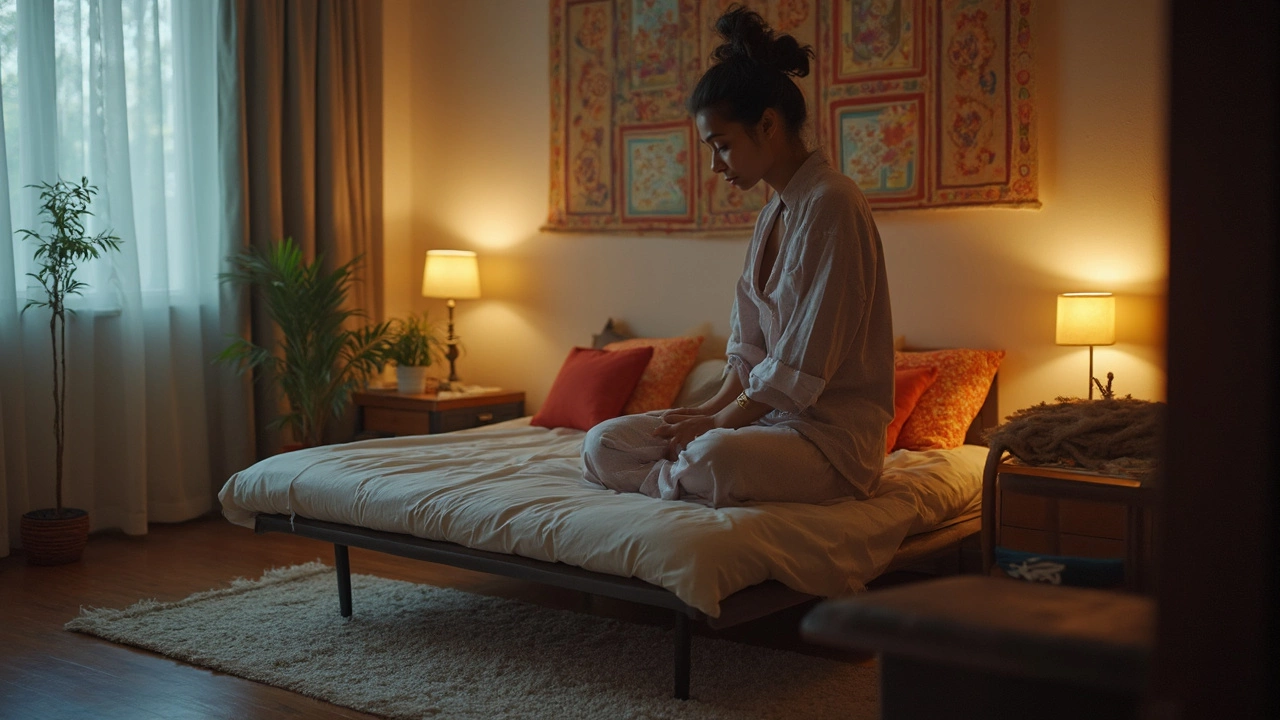So you're thinking about ditching your regular bed and making a sofa bed your main sleep spot. Maybe your studio apartment doesn't leave much choice, or you're just curious if it's worth the convenience. This question pops up a lot, especially for folks living in tight spaces or dealing with long-term guests.
The short answer? Yes, you can sleep on a sofa bed every night—but there's a real difference between "can" and "should." Most sofa beds were made for occasional use, like a guest crashing for a few nights. Their mattresses tend to be thinner and less supportive than proper beds, and the way they fold up can create lumps, dips, or metal bars right where your back lands. Not exactly spa treatment.
That being said, not all sofa beds are equal. Some modern designs actually feel pretty close to a real mattress, especially if you know what to look for. Upgrading with a good mattress topper (seriously, they're lifesavers), rotating your mattress, or even replacing the included mattress with a better one can make a world of difference. We'll dig into specific fixes and what to watch out for, but if you're stuck with only a sofa bed, it doesn't have to be miserable.
- What Makes a Sofa Bed Different?
- Comfort: What to Expect Night After Night
- Are Sofa Beds Bad for Your Health?
- How to Make a Sofa Bed Way More Sleepable
- When Is a Sofa Bed Actually a Good Idea for Permanent Sleep?
What Makes a Sofa Bed Different?
Regular beds and sofa beds are not built the same way—no surprises there, but the details really matter if you're going to sleep on one every night. Let’s break it down: a standard mattress and bed frame are designed purely for sleep. Sofa beds need to pull double duty. They have to work as a couch by day and flip into a bed at night. That means the frame, mattress, and even the padding are built to fold, collapse, and still look halfway decent in your living room.
The average sofa bed mattress is usually 4 to 5 inches thick, compared to standard mattresses that run 8 to 14 inches. Why so thin? Because it's got to fold into the couch. That can make a huge difference in comfort and support. Sofa beds often use memory foam or innerspring coils, but they're usually lower-quality stuff compared to what you'd find in real beds—mainly to keep costs and the weight down.
Check out this handy table for a quick side-by-side:
| Sofa Bed | Standard Bed | |
|---|---|---|
| Average Mattress Thickness | 4-5 inches | 8-14 inches |
| Purpose | Convertible seating/sleeping | Dedicated sleeping |
| Support Structure | Foldable metal/wood frame | Rigid slats/box spring |
| Mattress Material Quality | Medium/Low | Medium/High |
One of the biggest gripes about sofa beds is those dreaded metal bars you can feel through the mattress. William Fennell of the Sleep Foundation puts it this way:
"With most sofa beds, you’re sacrificing the thickness and full-body support found in conventional beds. That can make long-term nightly use tough on your back and neck."
But here’s the flip side: the latest sofa beds are trying to close the gap. Some even come with pocket coil mattresses or thicker memory foam toppers. Still, don’t expect miracles. Even the best ones will never quite match the feel of a legit bed because, at the end of the day, you’re still dealing with a sofa bed—not a full-scale mattress setup.
- Sofa beds save space, which is huge for small apartments and multipurpose rooms.
- They're good for surprise guests or occasional naps.
- Daily use means more wear and tear—frames can loosen and mattresses flatten faster than normal beds.
If you care about the little things like support, ease of setup, and how long the thing actually lasts, the differences between sofa beds and regular beds get a lot more obvious as time goes on.
Comfort: What to Expect Night After Night
If you’re planning to replace your regular bed with a sofa bed, the first thing you’ll notice is the difference in support and feel. Most sofa beds have a mattress that’s only about 3 to 5 inches thick—way thinner than the 8-to-12-inch mattresses most people sleep on. This means you might feel the frame or those infamous support bars after a few hours, especially if you sleep on your side or back. That’s the top reason people complain about stiffness and soreness after a few nights.
Pull-out mechanisms also play a role. Classic sofa beds with a fold-out metal frame can have lumpy areas or uneven weight support. Some newer models use memory foam or latex for their mattresses, which helps, but these models usually cost a lot more. Don’t bank on the cheaper options feeling great for the long haul.
Another big thing is motion transfer. If you share your sofa bed with someone, any small movement (like turning over) travels across the whole sleeping surface. It's not a huge deal if you sleep alone, but couples definitely notice it.
Let’s talk noise. Metal frames can creak, hinges can squeak, and some sofa beds get noisier as they age. If you’re a light sleeper, this might turn into a huge annoyance—earplugs or WD-40 can only do so much.
And about temperature: most sofa bed mattresses don't breathe well. You might find yourself sweating on memory foam or freezing on a thin coil mattress in the winter. If you're picky about sleeping temperature, you’ll want to use a mattress protector or a topper that helps regulate heat.
- Expect less cushioning and support, especially from basic models.
- You’ll probably notice lumps, dips, or bars right away if you’re used to a regular bed.
- Cheap sofa beds usually mean more aches and tougher mornings.
- Modern sofa beds with higher-end mattresses (think memory foam, thick latex) close the comfort gap—but cost way more.
If you’re thinking about making the switch, testing the sofa bed first is a smart move. Lie down, shift around, see how it feels on your back and side. A quick five-minute nap will tell you more than any spec sheet.

Are Sofa Beds Bad for Your Health?
This is where things get real. You probably know someone who woke up on a sofa bed with a sore neck or a stiff back. It’s not just bad luck—sofa beds really can mess with your body if you’re not careful, especially after weeks or months of use.
The main problems come down to support. Most sofa bed mattresses are between 3-4 inches thick, compared to the 8-12 inches you’ll see in a regular mattress. That extra thickness actually matters for your spine and pressure points. Without it, your body sinks into weird angles or hits a metal bar, leading to pain in your lower back, hips, or shoulders. One study from The Journal of Chiropractic Medicine found that people using thin mattresses reported more back pain after just one month compared to those on thicker mattresses.
If you’ve got allergies or asthma, keep in mind that many sofa beds use foam that traps dust or comes with less-breathable fabrics. They’re also not as easy to clean as a regular bed, so dust mites or pet hair stick around longer—nobody wants to wake up sneezing every morning.
Let’s get specific with the usual complaints people mention after long-term sofa bed sleeping:
- Back and neck pain from bad support
- Joint stiffness, especially in hips and shoulders
- Poor sleep quality, tossing and turning more during the night
- Waking up feeling tired, more so than after a night on a "real" mattress
- Increased allergies or respiratory issues if the sofa bed collects dust
Here’s a quick breakdown of how sofa beds stack up compared to regular beds when it comes to health:
| Health Factor | Sofa Bed | Traditional Mattress |
|---|---|---|
| Mattress Thickness | 3-4 inches | 8-12 inches |
| Spinal Support | Usually lacking | Usually good |
| Risk of Allergens | Higher | Lower (with good cleaning) |
| Sleep Quality | Lower, unless upgraded | Usually higher |
| Ease of Cleaning | Harder | Easier |
If you already have any back or joint problems, using a sofa bed long-term can make things worse. But if you’re healthy and young, you might not notice as many issues—at least at first. Listen to your body; if you start waking up sore, achy, or just grumpy, your "bed" might be the problem. Later on, I’ll share some hacks for making a sofa bed way better for your health and sleep.
How to Make a Sofa Bed Way More Sleepable
If you’re going to make a sofa bed your main bed, you’ve got to work with what you’ve got—and maybe upgrade some things. Tons of people struggle with metal bars poking them, cheap thin mattresses, and that funky fold in the middle. But you don’t have to settle for back pain and cranky mornings. Here’s how you can upgrade your sleep without buying a brand new bed.
- Invest in a quality mattress topper. A thick memory foam topper can smooth out lumps and add real support. People report that even a basic 3-inch topper feels completely different.
- Swap out the factory mattress. Many sofa bed mattresses are barely three to four inches thick. If yours feels shot, look for brands that sell replacement sofa bed mattresses—some have good reviews for durability and comfort.
- Add a thick blanket or comforter under the fitted sheet. This trick helps hide metal bars and rough spots if you don’t have a topper yet.
- Rotate your mattress often. Flipping or rotating can help it wear more evenly, which keeps it from getting saggy spots or dips.
- Deal with the bar-in-the-back problem. Some folks use folded towels or a folded yoga mat directly on top of the bars to soften them up before adding bedding.
Let’s look at some real-world numbers to get an idea of why these upgrades work. Check out this table comparing the average thickness and firmness (measured with a rating out of 10, 10 being the firmest) of typical sofa bed mattresses:
| Type | Average Thickness (inches) | Average Firmness (1-10) |
|---|---|---|
| Standard Sofa Bed Mattress | 3-4 | 5 |
| Memory Foam Topper Added | 5-7 | 6-8 |
| Premium Replacement Mattress | 4-5.5 | 7-9 |
Keep bedding simple, breathable, and easy to clean because sofa beds tend to trap heat more easily than regular beds. Skip heavy comforters if you run hot at night. And if your sofa bed is close to the ground, use a low-profile fan or a raised platform to keep airflow around your mattress.
Don’t ignore the little things: use supportive pillows, wash your bedding regularly, and keep clutter away so you can fold the bed out and put it away without a fight. Sometimes the basics go a long way toward better sleep.

When Is a Sofa Bed Actually a Good Idea for Permanent Sleep?
Honestly, a sofa bed can work as your main bed—but only in certain situations. It mostly comes down to your space, your expectations, and whether you’re willing to put in a little effort to make it work. Let’s break down when it actually makes sense and won’t wreck your back or your mood.
If you’re living in a small apartment or a studio, a sofa bed saves a ton of space. You get both seating and a bed without cluttering up your place. College students, new grads landing their first city pad, or anyone living in a micro-apartment often rely on this setup. If you don’t have a spare room for guests and want to host friends or family, a sofa bed in the living room also doubles as emergency sleeping space.
Some modern sofa beds fix a lot of the old issues that gave them a bad rap. High-end models use memory foam or pocket coil mattresses, which can feel pretty close to regular beds. Brands like IKEA, West Elm, and Joybird have models that get decent sleep reviews. Still, most people should test out the bed in person if possible before buying—what looks comfy in the showroom might not cut it for eight hours a night.
Sofa beds are also a good call if you need flexibility. Maybe you’re in a temporary living situation—staying with family, waiting for a new house, or working a short-term contract in another city—and don’t want to buy a full bed set. In these cases, a sofa bed makes your life easier and saves cash and hassle on moving heavy mattresses.
- Sofa bed works best if you have limited space and need your room to serve double duty.
- It’s practical for temporary living situations where buying a full bed doesn’t make sense.
- If you grab a model with a good mattress, especially memory foam, long-term use is much easier on your back and neck.
- Adding a quality mattress topper and keeping up with basic care (like flipping the mattress occasionally) upgrades your sleep quality.
Some real numbers help, too. Check out how modern sofa beds stack up versus regular beds in a few key ways:
| Feature | Sofa Bed | Regular Bed |
|---|---|---|
| Average Mattress Thickness | 4-5 inches | 10-14 inches |
| Designed For Nightly Use? | Some models only* | Yes |
| Price Range (Average) | $300 - $1,800 | $500 - $2,500 |
| Setup Time | 1-2 minutes/night | None |
| Space Saved | High | Low |
*Check product specs—some sofa beds are labeled for “frequent” or “permanent” use. Don’t assume all of them work for nightly sleep.
If you’re under 30, healthy, don’t have major back or joint issues, and you actually upgrade the mattress, sleeping on a sofa bed is way more doable. For couples, look for queen or king-size options. Stay away from the old-school pull-out models with the metal bar of doom. Look for trifold memory foam or platform-style frames instead.
Last tip: if you’re going permanent, set up a real bedtime routine and air out your sofa bed often so it stays fresh. Small tweaks go a long way if this is your everyday sleep spot.

